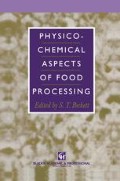Abstract
Preserves have been consumed for many hundreds of years. Originally, they were produced domestically and made primarily to extend the life of fruit, beyond the few weeks following harvesting, by cooking in the presence of high concentrations of sugar, hence giving rise to the name preserves. Over the years the resultant product became a specialised food in its own right rather than a means of preservation, with the characteristics we expect of it today, namely that it should be a spreadable gelled or semi-gelled system. In many cases, fruit pieces are present and it is important that these should be softened and spreadable along with the gel.
Access this chapter
Tax calculation will be finalised at checkout
Purchases are for personal use only
Preview
Unable to display preview. Download preview PDF.
References
Bloomfield, R.W. Preserves. In Food Industries Manual, 22nd edn. Ed. Rankin, R.D. (1988), Blackie and Sons, Glasgow, 335–355.
Pilink, W. and Voragen, A.G.J. Alginate and pectin. In Gelling and Thickening Agents in Foods. Eds Neukon, H. and Pilnik, W. (1980), Forster Publishing, Zurich.
Pilnik, W. Pectin — A many spendoured thing. In Gums and Stabilisers in the Food Industry, 5th edn. Phillips, CO., Wedlock, D.J. and Williams, P.A. (1990), IRL Press, Oxford.
Christensen, S.H. Pectins. In Food Hydrocolloids. Volume 3. Ed. Glickman, M. (1986), CRC Press, Boca Raton, Florida.
Oakenfell, D.G. The chemistry of high-methoxyl pectins. In The Chemistry and Technology of Pectin. Ed. Walker, R.H. (1991), Academic Press, San Diego, California.
Robin, C. and Devries, J. Pectin. In Food Gels. Ed. Harries, P. (1990), Elsevier Applied Science Publishers, Amsterdam, 401–434.
May, C.D. and Strainsby, G. Factors affecting pectin gelation. In Gums and Stabilisers in the Food Industry. Volume 3. Eds Phillis, G.O., Wedlock D.J. and Williams, P.A. (1986), Elsevier Applied Science Publishers, Barking, Essex.
Crandall, P.G. and Wicker, L. Pectin internal gel strength: Theory, measurement and methodology. In Chemistry and Function of Pectins. Eds Fishman, M.L. and Jen, J.J. (1986), American Chemical Society, Washington DC.
May, C.D. Industrial pectins: sources, production and applications. Carbohydrate Polymers 12 (1990), 79–99.
Lohmann, R. Pektine. Zur Herstelling von Konfitüren, Marmeladen und Gelees. Gordonian 77(10) (1977), 165–272.
Thiabault, J.F. and Petit, R. Pectin substances: general information and areas of application in the food industry [translated from French] Industries Alimentaires et Agricoles 96(12) (1979), 1231–1240.
May, C.D. Pectins for the food industry. Food Technology International, Europe (1989), 269–271.
King, K. Pectin — an untapped natural resource. Food Science and Technology Today 7(3) (1993), 147–152.
Ludwig, H., Bieler, C., Hallbauer, K. and Scigalla, W. Inactivation of micro-organisms by hydrostatic pressure. In Proceedings of the First European Seminar on High Pressure and Biotechnology, September 1992, France, Eds Balny, C., Hayashi, R., Heremans, K. and Masson, P., 25
Kimura, K. Development of a new fruit processing method by high hydrostatic pressure. In Proceeding of the First European Seminar on High Pressure and Biotechnology September 1992, France. Eds Bainy, C., Hayashi, R., Heremans, K. and Masson, P., 279.
Horie, Y., Kiluralola, M., Yoshida, Y. and Okki K. Studies on pressure processing of jam. In High Pressure Science for Food. Ed Hayashi, R. (1991), 336.
Watanabe, M., Aria, E., Kumeno, K. and Honma K. A new method for producing a non-heated jam sample. Agricultural and Biological Chemistry 55(8) (1991), 2175.
Editor information
Editors and Affiliations
Rights and permissions
Copyright information
© 1995 Chapman & Hall
About this chapter
Cite this chapter
Bowler, P., Loh, V.Y., Marsh, R.A. (1995). Preserves and jellies. In: Beckett, S.T. (eds) Physico-Chemical Aspects of Food Processing. Springer, Boston, MA. https://doi.org/10.1007/978-1-4613-1227-7_15
Download citation
DOI: https://doi.org/10.1007/978-1-4613-1227-7_15
Publisher Name: Springer, Boston, MA
Print ISBN: 978-0-7514-0240-7
Online ISBN: 978-1-4613-1227-7
eBook Packages: Springer Book Archive

